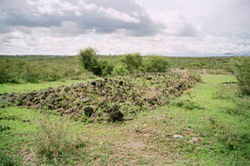Australopithecus afarensis footprint
Cast of the "Laetoli footprints" -- the earliest known human footprints in the world, on display in the Hall of Human Origins in the Smithsonian Museum of Natural History in Washington, D.C.
These footprints are those of Australopithecus afarensis. The entire footprint trail is 88 feet long and includes impressions left by two early humans. They were made 3.6 million years ago in Laetoli, Tanzania, when A. afarensis walked through wet volcanic ash. Paleontologist Mary Leakey found them in 1976, but they were not identified until Paul Abell did so in 1978. There are 70 footprints in total.
Australopithecus afarensis is an extinct human ancestor that lived between 3.9 to 2.9 million years ago. It is more closely related to human beings that Australopithecus africanus, which also lived at about the same time. Australopithecus afarensis was discovered in the Afar region of Ethiopia (hence the name "afarensis") in November 1973. The genus name, "Australopithecus", comes from the Latin word australis (or "southern") and the Greek word pithekos ("ape").
The most famous find is a partial skeleton discovered on November 24, 1974. It was named named Lucy because the scientists who found it repeatedly played the song "Lucy in the Sky with Diamonds" in celebration.Relevantní obrázky
Relevantní články
LaetoliLaetoli je oblast významných paleoantropologických lokalit z období pliocénu a pleistocénu, která se nachází poblíž kráteru Ngorongoro v severní Tanzanii, zhruba 30 km jihozápadně od Olduvajské rokle. Místo je světově proslulé především díky otiskům stop pliocenních živočichů ve vrstvě sopečného popela. Jako součást chráněné oblasti Ngorongoro patří od roku 1979 na seznam světového dědictví UNESCO. .. pokračovat ve čtení







